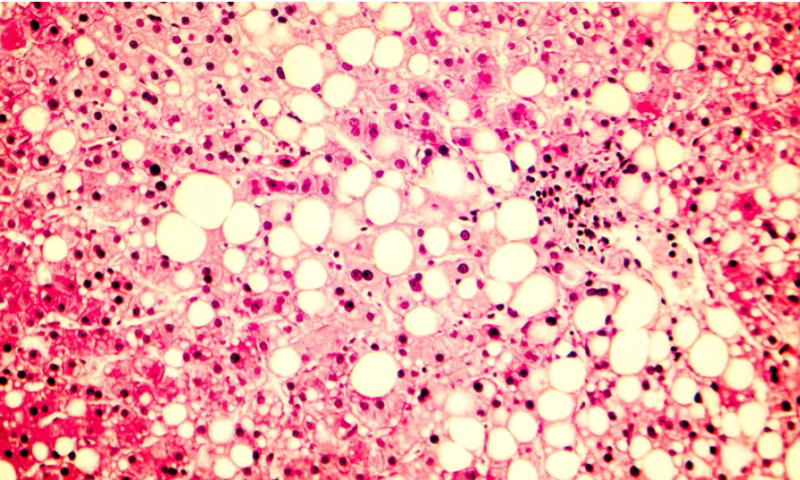Scientists have discovered that nicotine accumulation in the intestines of tobacco smokers drives the progression of nonalcoholic steatohepatitis, or NASH—and that a nicotine-degrading gut bacterium could be useful in treating the disease.
In a study published Oct. 19 in Nature, a research team led by Frank Gonzalez, Ph.D., of the National Cancer Institute reported that it had characterized the mechanism by which nicotine interacts with compounds in the intestine and ultimately leads to NASH, one of several conditions classified as a nonalcoholic fatty liver disease.
The team also showed that the bacterium Bacteroides xylanisolvens is capable of breaking down nicotine particles and that NASH-afflicted mice with the microbe in their gut had both lower concentrations of nicotine in their intestines and less severe disease.
The researchers built upon previous work showing an association between nicotine and NASH along with studies that posited bacterial enzymes as a solution for removing nicotine from the organs of smokers. While a relationship between smoking and nonalcoholic fatty liver disease has been clear for some time, this was the first time scientists had pinpointed a possible mechanism. It was also the first time they had verified the presence of gut microbiota that are capable of breaking down nicotine.
First, to confirm that nicotine does indeed build up in the intestines of smokers, the scientists analyzed stool, gut lining and serum samples from 30 smokers and compared them with samples from 30 nonsmokers. As expected, nicotine levels were higher in the smokers’ samples. Those findings were then replicated in mice: A group that received nicotine orally, via smoke exposure or through subcutaneous injection had much more nicotine in their intestines and other organs than the control group.
Next, the researchers sought to find out whether the composition of the gut microbiome could influence nicotine levels. To that end, they gave nicotine-infused drinking water to two sets of mice—one group without any bacteria in their microbiome, also known as “germ-free” mice, and a control group that was clear of select bacterial pathogens. More nicotine accumulated in the organs of the germ-free mice than in the controls, suggesting that gut bacteria were eliminating it.
To figure out which microbes were doing the job, the scientists screened a public genome database for bacteria that contained the genes for enzymes that were known to break down nicotine. After further analysis of stool and serum samples from human smokers, one microbe stood out: B. xylanisolvens, which was plentiful in samples with the lowest amounts of nicotine.
Colonizing B. xylanisolvens in mice that were subsequently exposed to nicotine confirmed what the scientists had seen in the samples—the bacterium was capable of breaking nicotine down in vivo. Further experiments revealed that an enzyme called NicX was doing the work; expressing the NicX gene in fellow bacteria E. coli gave it nicotine-degrading powers. Meanwhile, knocking out the gene for NicX in B. xylanisolvens took away their ability to break it down.
The scientists then set up mouse experiments to see whether B. xylanisolvens colonization was enough to ward off NASH. It was: Mice who were fed a high-fat, high-fructose diet and given nicotine in their water—conditions that mimic those that lead to NASH in humans—had less liver hardening, inflammation and fibrosis if their gut microbiota were colonized with B. xylanisolvens.
But how was nicotine leading to NASH in the first place? To answer this, the scientists focused on intestinal AMP kinase alpha-1, a cellular “sensor” involved in maintaining energy homeostasis that had previously been shown to interact with nicotine. A series of experiments revealed that nicotine activates AMP kinase alpha-1, which then activates another enzyme, SMPD3. SMPD3 regulates the production of ceramides, a type of lipid.
Earlier studies had already associated high SMPD3 levels with the progression of metabolic disease. The same was true for NASH. Suppressing the enzyme in mice who were given nicotine ameliorated the NASH progression, the current study showed.
Finally, the researchers assessed whether B. xylanisolvens might be useful against NASH in a clinical setting. Examining samples from 83 smoking and nonsmoking patients with biopsy-proven nonalcoholic fatty liver disease, they found that higher levels B. xylanisolvens levels in the smoking patients were associated with lower disease severity. However, those findings didn’t extend to nonsmoking patients, suggesting that the bacteria’s nicotine-degrading properties were specifically responsible for protecting smokers against NASH.
“This study indicates that interventions with either microbial nicotine degraders or other targets based on the intestinal AMPKα–SMPD3–ceramide axis show translational potential for the treatment of nicotine-associated NASH,” the researchers wrote in their paper.

